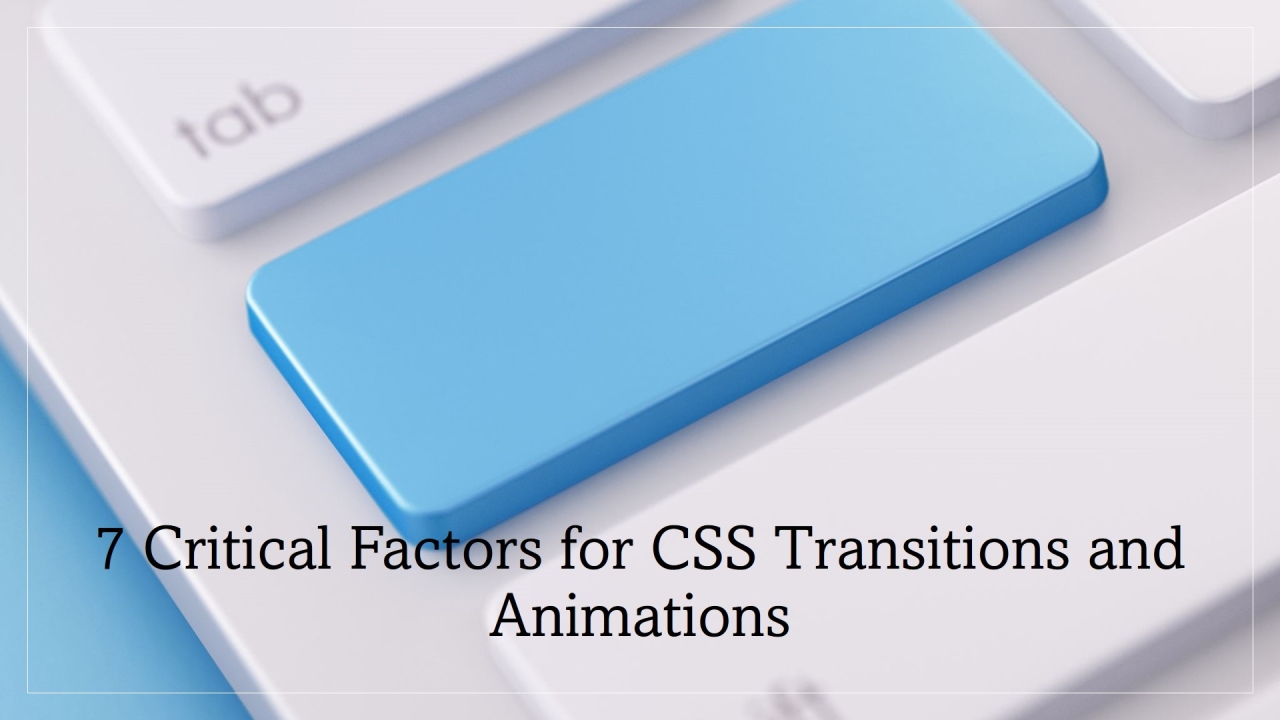
CSS Transitions vs Animations: 7 Critical Factors to Skyrocket Your Web Performance (Choose Wisely!)
In the ever-evolving landscape of web development, creating smooth, engaging user interfaces is paramount. Two powerful tools at your disposal are CSS transitions and animations. But which one should you choose for your project? This article will delve into the crucial differences between CSS transitions and animations, providing you with the knowledge to make informed decisions that will elevate your web design and boost performance. By understanding these seven critical factors, you'll be equipped to create stunning, efficient web experiences that captivate your audience and drive results.
Understanding the Basics: Transitions vs Animations
Before we dive into the decision-making process, let's clarify the fundamental differences between CSS transitions and animations.
FAQ: What are the basic definitions of CSS transitions and animations?
CSS Transitions: These allow property changes in CSS values to occur smoothly over a specified duration. They're ideal for simple, single-state changes.
CSS Animations: These use keyframes to define multiple steps in an animation sequence, allowing for more complex, multi-state animations.
Performance Considerations
When it comes to web development, performance is king. Both transitions and animations can impact your site's speed and responsiveness.
FAQ: Which is more performance-efficient: transitions or animations?
Generally, transitions are more performance-efficient for simple state changes. They require less code and are optimized by browsers. However, for complex, multi-step animations, CSS animations can be more efficient than trying to chain multiple transitions.
Key Statistic: According to a study by Google, pages that use efficient animations and transitions can see up to a 70% increase in user engagement.
Complexity and Control
The level of complexity and control you need will greatly influence your choice between transitions and animations.
FAQ: When should I use animations instead of transitions?
Use animations when you need:
Transitions are sufficient for simple hover effects or state changes.
Browser Support and Fallbacks
While both transitions and animations have good browser support, it's essential to consider older browsers and fallback options.
FAQ: How do browser support and fallbacks differ for transitions and animations?
Both transitions and animations have excellent support in modern browsers. However, transitions generally have slightly better support in older browsers. For both, it's crucial to provide fallbacks:
.element {
/* Fallback for browsers that don't support transitions */
margin-left: 100px;
/* Transition for supported browsers */
transition: margin-left 0.5s ease-in-out;
}
.element:hover {
margin-left: 150px;
}
Trigger Mechanisms
Understanding how transitions and animations are triggered can help you choose the right option for your specific use case.
领英推荐
FAQ: How are transitions and animations typically triggered?
Transitions are typically triggered by:
Animations can be triggered by:
This difference makes transitions ideal for user-interaction based effects, while animations are great for automatic or scripted sequences.
Keyframe Flexibility
The ability to define multiple steps in an animation sequence is a key differentiator between transitions and animations.
FAQ: How do keyframes in animations differ from transitions?
Animations allow you to define multiple keyframes, giving you precise control over intermediate steps:
@keyframes slide-fade {
0% { opacity: 0; transform: translateX(-100%); }
50% { opacity: 0.5; transform: translateX(-50%); }
100% { opacity: 1; transform: translateX(0); }
}
Transitions, on the other hand, only define a start and end state, with the browser interpolating the in-between values.
Reusability and Maintenance
Consider the long-term implications of your choice on code reusability and maintenance.
FAQ: Which is more reusable and easier to maintain: transitions or animations?
Animations often provide better reusability, as you can define a set of keyframes once and apply them to multiple elements with different durations, directions, or timing functions. This can lead to more maintainable code in complex projects.
Transitions, while simpler, may require more repetition if you need the same effect on multiple elements.
Conclusion
Choosing between CSS transitions and animations is not a one-size-fits-all decision. By considering these seven critical factors – performance, complexity, control, browser support, trigger mechanisms, keyframe flexibility, and reusability – you can make informed choices that will enhance your web projects. Remember, the goal is to create smooth, engaging user experiences that perform well across devices and browsers. Whether you opt for the simplicity of transitions or the power of animations, your decision should always be guided by the specific needs of your project and the experience you want to create for your users. By mastering these techniques, you'll be well-equipped to create web experiences that not only look great but also drive engagement and conversions.
#CSStransitions, #CSSanimations, #webperformance, #UXdesign, #frontenddevelopment, #webanimations, #CSS, #webdesigntechniques, #userengagement, #responsivedesign
Tags:
Interesting ????